Examining Cultural Competence in Healthcare for African Americans
VerifiedAdded on 2023/06/04
|8
|2113
|416
Essay
AI Summary
This essay explores the critical role of cultural competence in healthcare, particularly in addressing health disparities within the African American community in the United States. It examines demographic shifts, socioeconomic factors, genetics, age, sexual orientation, gender, and race as contributors to these disparities, with a specific focus on the prevalence of type 2 diabetes among African Americans. The essay highlights the impact of socioeconomic status, cultural beliefs, environmental factors, and barriers to healthcare access on health outcomes. It concludes by emphasizing the need for further research into the social determinants of health disparities to formulate effective strategies for combating these inequalities and improving health equity. Desklib offers a platform for students to access this essay and other study tools.
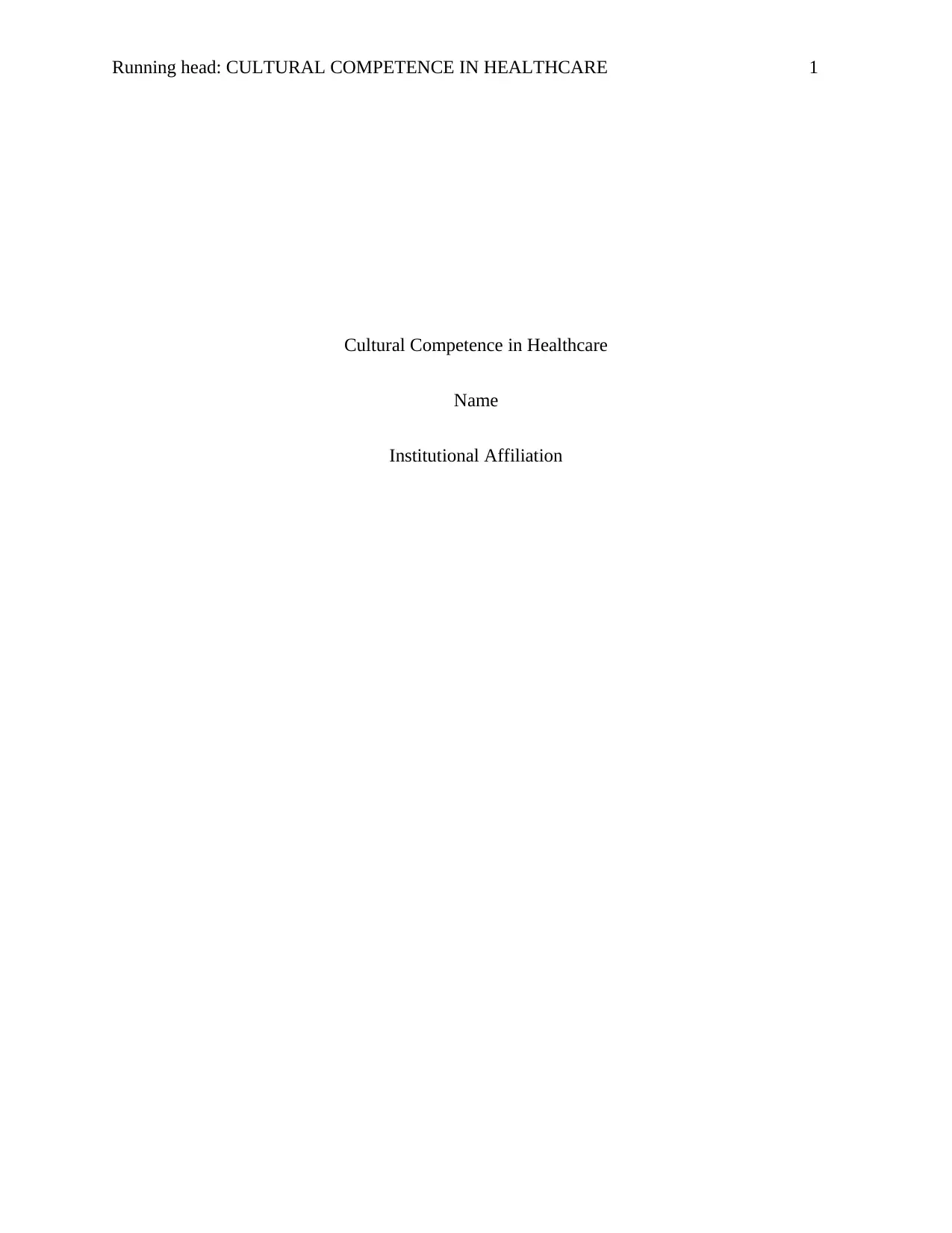
Running head: CULTURAL COMPETENCE IN HEALTHCARE 1
Cultural Competence in Healthcare
Name
Institutional Affiliation
Cultural Competence in Healthcare
Name
Institutional Affiliation
Paraphrase This Document
Need a fresh take? Get an instant paraphrase of this document with our AI Paraphraser
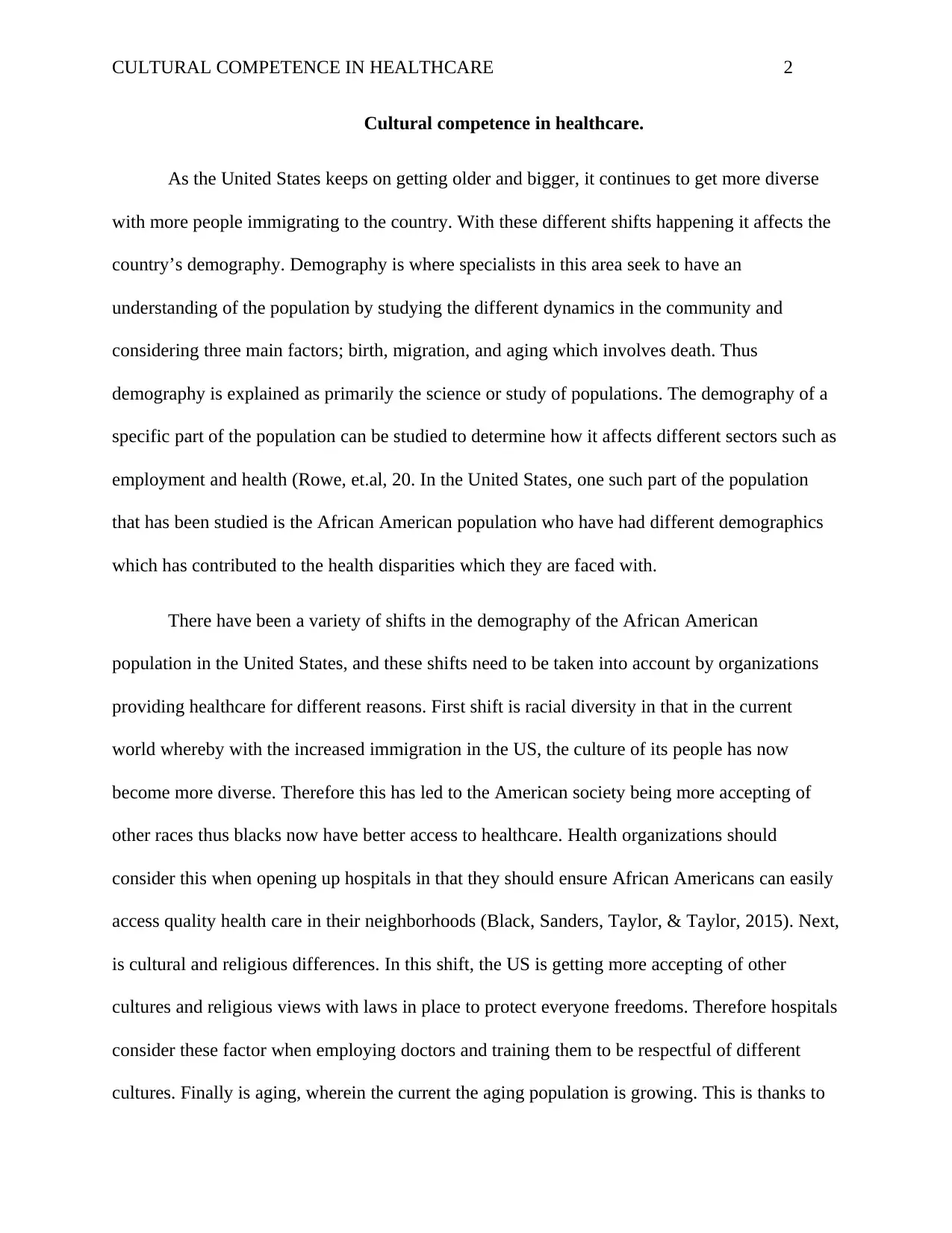
CULTURAL COMPETENCE IN HEALTHCARE 2
Cultural competence in healthcare.
As the United States keeps on getting older and bigger, it continues to get more diverse
with more people immigrating to the country. With these different shifts happening it affects the
country’s demography. Demography is where specialists in this area seek to have an
understanding of the population by studying the different dynamics in the community and
considering three main factors; birth, migration, and aging which involves death. Thus
demography is explained as primarily the science or study of populations. The demography of a
specific part of the population can be studied to determine how it affects different sectors such as
employment and health (Rowe, et.al, 20. In the United States, one such part of the population
that has been studied is the African American population who have had different demographics
which has contributed to the health disparities which they are faced with.
There have been a variety of shifts in the demography of the African American
population in the United States, and these shifts need to be taken into account by organizations
providing healthcare for different reasons. First shift is racial diversity in that in the current
world whereby with the increased immigration in the US, the culture of its people has now
become more diverse. Therefore this has led to the American society being more accepting of
other races thus blacks now have better access to healthcare. Health organizations should
consider this when opening up hospitals in that they should ensure African Americans can easily
access quality health care in their neighborhoods (Black, Sanders, Taylor, & Taylor, 2015). Next,
is cultural and religious differences. In this shift, the US is getting more accepting of other
cultures and religious views with laws in place to protect everyone freedoms. Therefore hospitals
consider these factor when employing doctors and training them to be respectful of different
cultures. Finally is aging, wherein the current the aging population is growing. This is thanks to
Cultural competence in healthcare.
As the United States keeps on getting older and bigger, it continues to get more diverse
with more people immigrating to the country. With these different shifts happening it affects the
country’s demography. Demography is where specialists in this area seek to have an
understanding of the population by studying the different dynamics in the community and
considering three main factors; birth, migration, and aging which involves death. Thus
demography is explained as primarily the science or study of populations. The demography of a
specific part of the population can be studied to determine how it affects different sectors such as
employment and health (Rowe, et.al, 20. In the United States, one such part of the population
that has been studied is the African American population who have had different demographics
which has contributed to the health disparities which they are faced with.
There have been a variety of shifts in the demography of the African American
population in the United States, and these shifts need to be taken into account by organizations
providing healthcare for different reasons. First shift is racial diversity in that in the current
world whereby with the increased immigration in the US, the culture of its people has now
become more diverse. Therefore this has led to the American society being more accepting of
other races thus blacks now have better access to healthcare. Health organizations should
consider this when opening up hospitals in that they should ensure African Americans can easily
access quality health care in their neighborhoods (Black, Sanders, Taylor, & Taylor, 2015). Next,
is cultural and religious differences. In this shift, the US is getting more accepting of other
cultures and religious views with laws in place to protect everyone freedoms. Therefore hospitals
consider these factor when employing doctors and training them to be respectful of different
cultures. Finally is aging, wherein the current the aging population is growing. This is thanks to
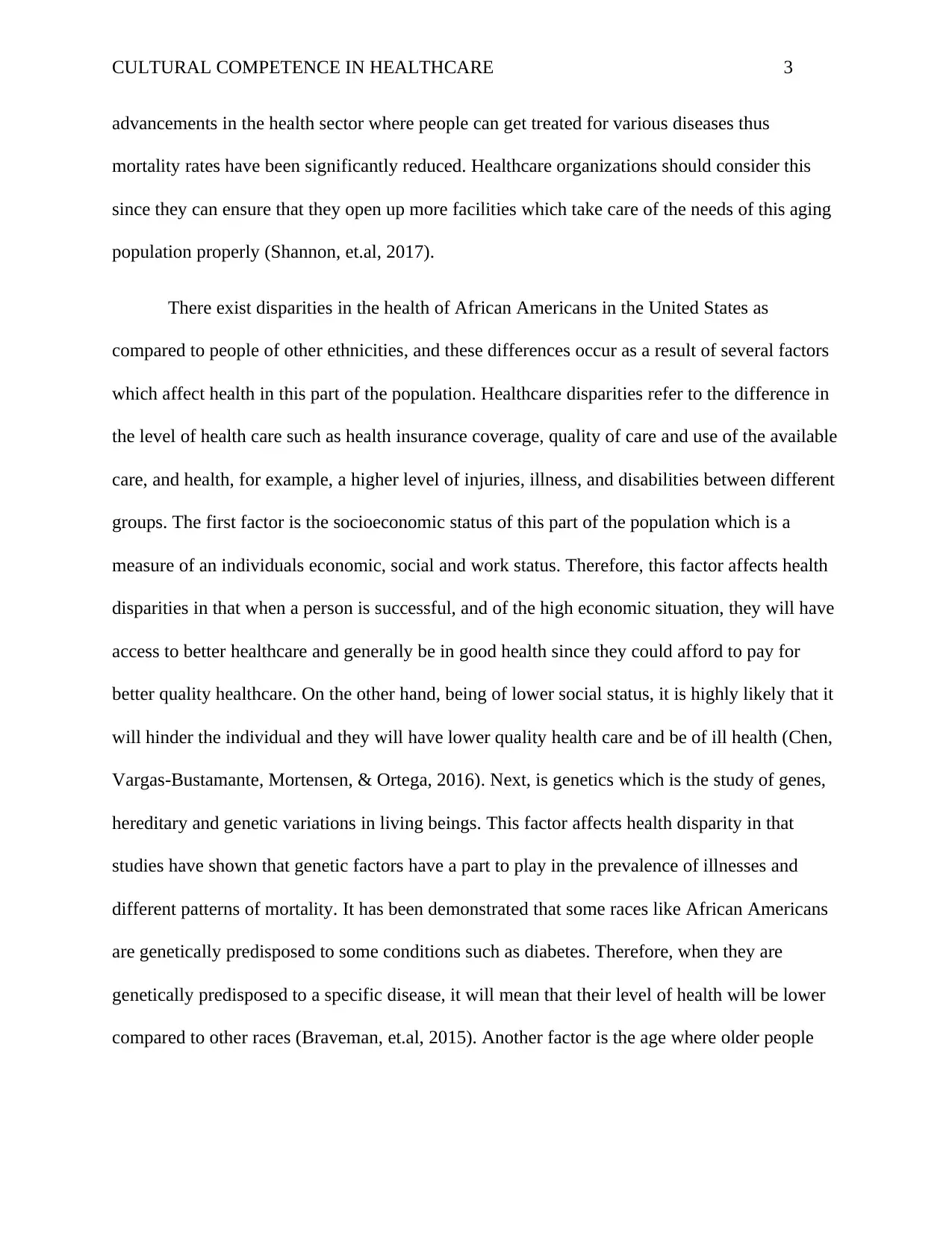
CULTURAL COMPETENCE IN HEALTHCARE 3
advancements in the health sector where people can get treated for various diseases thus
mortality rates have been significantly reduced. Healthcare organizations should consider this
since they can ensure that they open up more facilities which take care of the needs of this aging
population properly (Shannon, et.al, 2017).
There exist disparities in the health of African Americans in the United States as
compared to people of other ethnicities, and these differences occur as a result of several factors
which affect health in this part of the population. Healthcare disparities refer to the difference in
the level of health care such as health insurance coverage, quality of care and use of the available
care, and health, for example, a higher level of injuries, illness, and disabilities between different
groups. The first factor is the socioeconomic status of this part of the population which is a
measure of an individuals economic, social and work status. Therefore, this factor affects health
disparities in that when a person is successful, and of the high economic situation, they will have
access to better healthcare and generally be in good health since they could afford to pay for
better quality healthcare. On the other hand, being of lower social status, it is highly likely that it
will hinder the individual and they will have lower quality health care and be of ill health (Chen,
Vargas-Bustamante, Mortensen, & Ortega, 2016). Next, is genetics which is the study of genes,
hereditary and genetic variations in living beings. This factor affects health disparity in that
studies have shown that genetic factors have a part to play in the prevalence of illnesses and
different patterns of mortality. It has been demonstrated that some races like African Americans
are genetically predisposed to some conditions such as diabetes. Therefore, when they are
genetically predisposed to a specific disease, it will mean that their level of health will be lower
compared to other races (Braveman, et.al, 2015). Another factor is the age where older people
advancements in the health sector where people can get treated for various diseases thus
mortality rates have been significantly reduced. Healthcare organizations should consider this
since they can ensure that they open up more facilities which take care of the needs of this aging
population properly (Shannon, et.al, 2017).
There exist disparities in the health of African Americans in the United States as
compared to people of other ethnicities, and these differences occur as a result of several factors
which affect health in this part of the population. Healthcare disparities refer to the difference in
the level of health care such as health insurance coverage, quality of care and use of the available
care, and health, for example, a higher level of injuries, illness, and disabilities between different
groups. The first factor is the socioeconomic status of this part of the population which is a
measure of an individuals economic, social and work status. Therefore, this factor affects health
disparities in that when a person is successful, and of the high economic situation, they will have
access to better healthcare and generally be in good health since they could afford to pay for
better quality healthcare. On the other hand, being of lower social status, it is highly likely that it
will hinder the individual and they will have lower quality health care and be of ill health (Chen,
Vargas-Bustamante, Mortensen, & Ortega, 2016). Next, is genetics which is the study of genes,
hereditary and genetic variations in living beings. This factor affects health disparity in that
studies have shown that genetic factors have a part to play in the prevalence of illnesses and
different patterns of mortality. It has been demonstrated that some races like African Americans
are genetically predisposed to some conditions such as diabetes. Therefore, when they are
genetically predisposed to a specific disease, it will mean that their level of health will be lower
compared to other races (Braveman, et.al, 2015). Another factor is the age where older people
⊘ This is a preview!⊘
Do you want full access?
Subscribe today to unlock all pages.

Trusted by 1+ million students worldwide
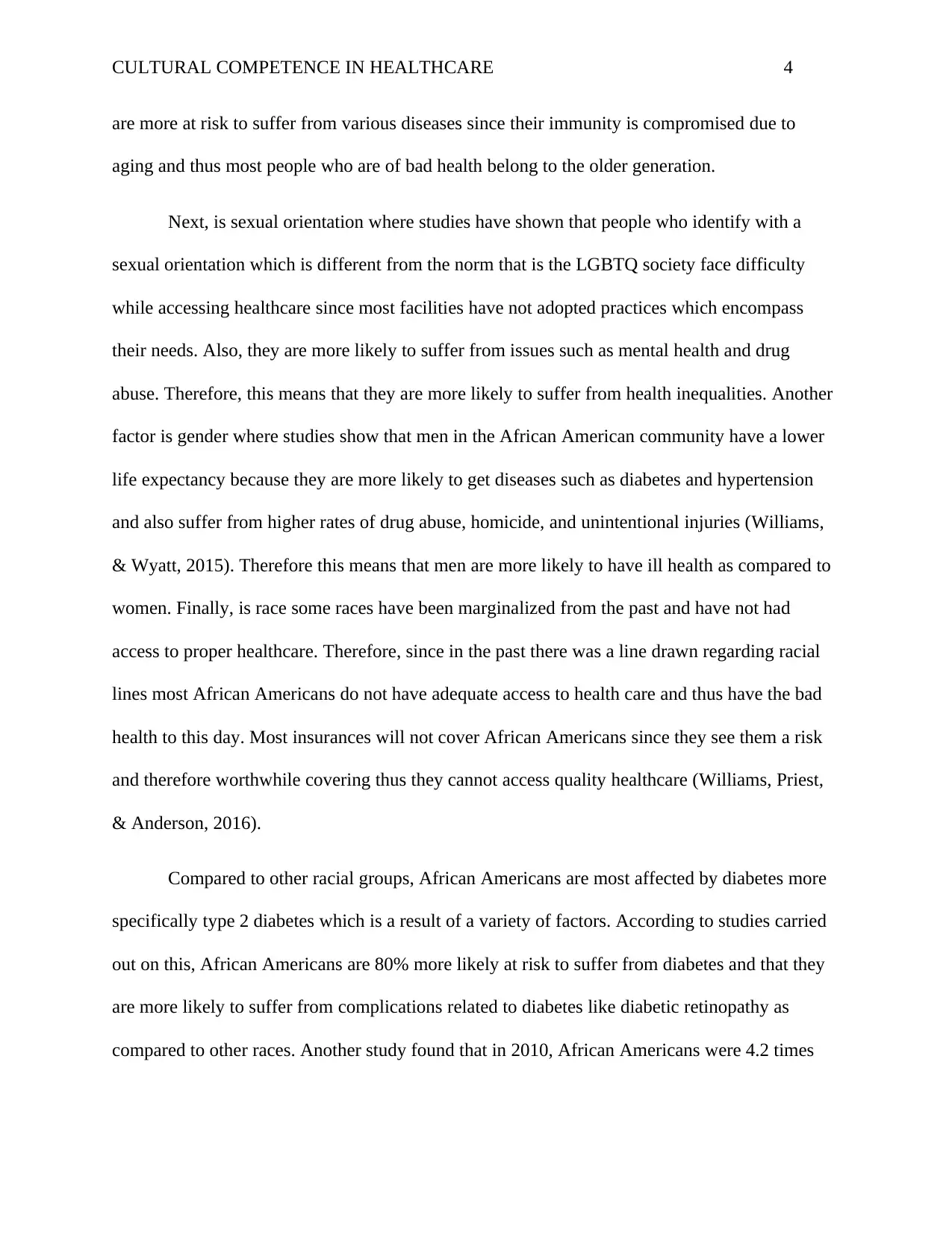
CULTURAL COMPETENCE IN HEALTHCARE 4
are more at risk to suffer from various diseases since their immunity is compromised due to
aging and thus most people who are of bad health belong to the older generation.
Next, is sexual orientation where studies have shown that people who identify with a
sexual orientation which is different from the norm that is the LGBTQ society face difficulty
while accessing healthcare since most facilities have not adopted practices which encompass
their needs. Also, they are more likely to suffer from issues such as mental health and drug
abuse. Therefore, this means that they are more likely to suffer from health inequalities. Another
factor is gender where studies show that men in the African American community have a lower
life expectancy because they are more likely to get diseases such as diabetes and hypertension
and also suffer from higher rates of drug abuse, homicide, and unintentional injuries (Williams,
& Wyatt, 2015). Therefore this means that men are more likely to have ill health as compared to
women. Finally, is race some races have been marginalized from the past and have not had
access to proper healthcare. Therefore, since in the past there was a line drawn regarding racial
lines most African Americans do not have adequate access to health care and thus have the bad
health to this day. Most insurances will not cover African Americans since they see them a risk
and therefore worthwhile covering thus they cannot access quality healthcare (Williams, Priest,
& Anderson, 2016).
Compared to other racial groups, African Americans are most affected by diabetes more
specifically type 2 diabetes which is a result of a variety of factors. According to studies carried
out on this, African Americans are 80% more likely at risk to suffer from diabetes and that they
are more likely to suffer from complications related to diabetes like diabetic retinopathy as
compared to other races. Another study found that in 2010, African Americans were 4.2 times
are more at risk to suffer from various diseases since their immunity is compromised due to
aging and thus most people who are of bad health belong to the older generation.
Next, is sexual orientation where studies have shown that people who identify with a
sexual orientation which is different from the norm that is the LGBTQ society face difficulty
while accessing healthcare since most facilities have not adopted practices which encompass
their needs. Also, they are more likely to suffer from issues such as mental health and drug
abuse. Therefore, this means that they are more likely to suffer from health inequalities. Another
factor is gender where studies show that men in the African American community have a lower
life expectancy because they are more likely to get diseases such as diabetes and hypertension
and also suffer from higher rates of drug abuse, homicide, and unintentional injuries (Williams,
& Wyatt, 2015). Therefore this means that men are more likely to have ill health as compared to
women. Finally, is race some races have been marginalized from the past and have not had
access to proper healthcare. Therefore, since in the past there was a line drawn regarding racial
lines most African Americans do not have adequate access to health care and thus have the bad
health to this day. Most insurances will not cover African Americans since they see them a risk
and therefore worthwhile covering thus they cannot access quality healthcare (Williams, Priest,
& Anderson, 2016).
Compared to other racial groups, African Americans are most affected by diabetes more
specifically type 2 diabetes which is a result of a variety of factors. According to studies carried
out on this, African Americans are 80% more likely at risk to suffer from diabetes and that they
are more likely to suffer from complications related to diabetes like diabetic retinopathy as
compared to other races. Another study found that in 2010, African Americans were 4.2 times
Paraphrase This Document
Need a fresh take? Get an instant paraphrase of this document with our AI Paraphraser
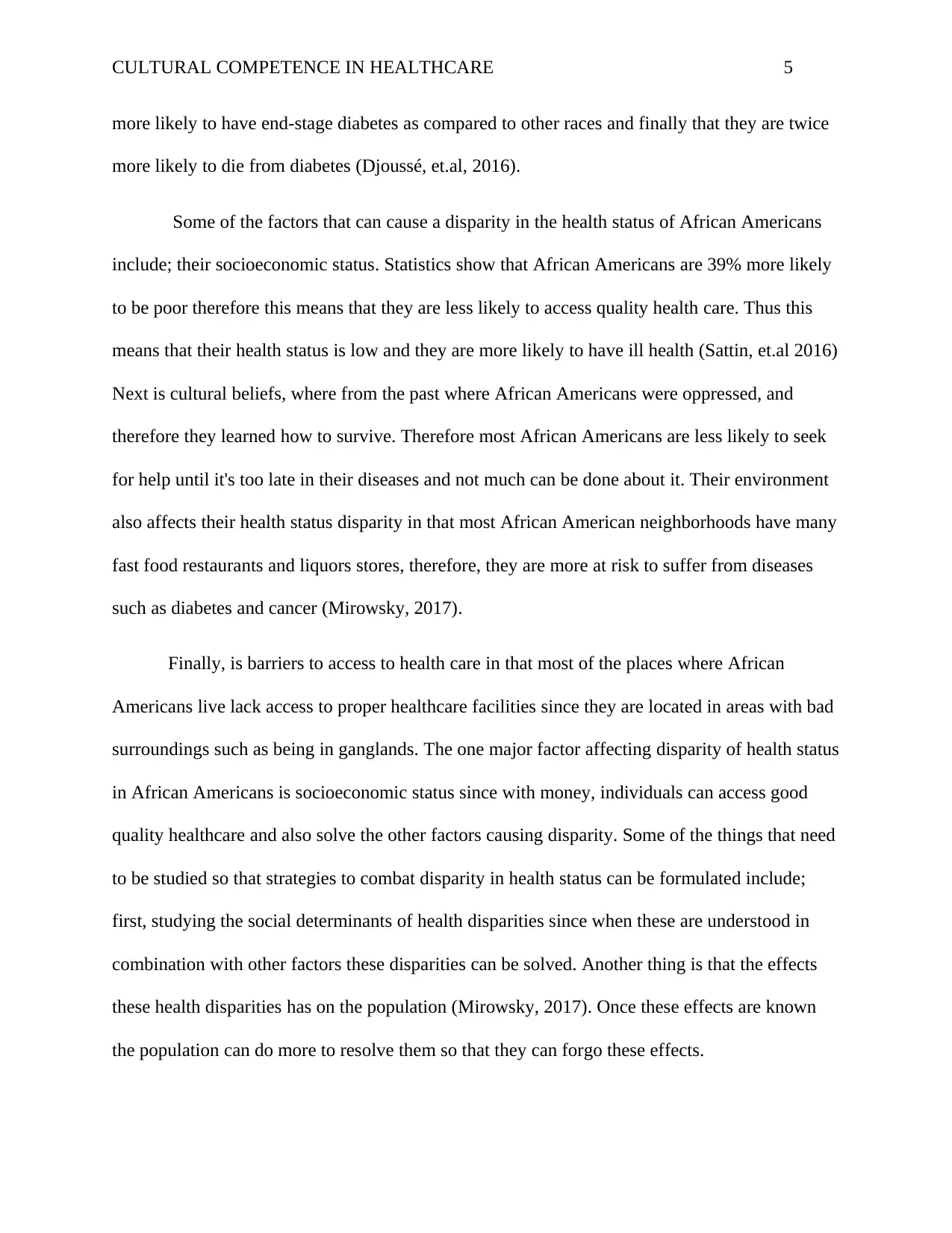
CULTURAL COMPETENCE IN HEALTHCARE 5
more likely to have end-stage diabetes as compared to other races and finally that they are twice
more likely to die from diabetes (Djoussé, et.al, 2016).
Some of the factors that can cause a disparity in the health status of African Americans
include; their socioeconomic status. Statistics show that African Americans are 39% more likely
to be poor therefore this means that they are less likely to access quality health care. Thus this
means that their health status is low and they are more likely to have ill health (Sattin, et.al 2016)
Next is cultural beliefs, where from the past where African Americans were oppressed, and
therefore they learned how to survive. Therefore most African Americans are less likely to seek
for help until it's too late in their diseases and not much can be done about it. Their environment
also affects their health status disparity in that most African American neighborhoods have many
fast food restaurants and liquors stores, therefore, they are more at risk to suffer from diseases
such as diabetes and cancer (Mirowsky, 2017).
Finally, is barriers to access to health care in that most of the places where African
Americans live lack access to proper healthcare facilities since they are located in areas with bad
surroundings such as being in ganglands. The one major factor affecting disparity of health status
in African Americans is socioeconomic status since with money, individuals can access good
quality healthcare and also solve the other factors causing disparity. Some of the things that need
to be studied so that strategies to combat disparity in health status can be formulated include;
first, studying the social determinants of health disparities since when these are understood in
combination with other factors these disparities can be solved. Another thing is that the effects
these health disparities has on the population (Mirowsky, 2017). Once these effects are known
the population can do more to resolve them so that they can forgo these effects.
more likely to have end-stage diabetes as compared to other races and finally that they are twice
more likely to die from diabetes (Djoussé, et.al, 2016).
Some of the factors that can cause a disparity in the health status of African Americans
include; their socioeconomic status. Statistics show that African Americans are 39% more likely
to be poor therefore this means that they are less likely to access quality health care. Thus this
means that their health status is low and they are more likely to have ill health (Sattin, et.al 2016)
Next is cultural beliefs, where from the past where African Americans were oppressed, and
therefore they learned how to survive. Therefore most African Americans are less likely to seek
for help until it's too late in their diseases and not much can be done about it. Their environment
also affects their health status disparity in that most African American neighborhoods have many
fast food restaurants and liquors stores, therefore, they are more at risk to suffer from diseases
such as diabetes and cancer (Mirowsky, 2017).
Finally, is barriers to access to health care in that most of the places where African
Americans live lack access to proper healthcare facilities since they are located in areas with bad
surroundings such as being in ganglands. The one major factor affecting disparity of health status
in African Americans is socioeconomic status since with money, individuals can access good
quality healthcare and also solve the other factors causing disparity. Some of the things that need
to be studied so that strategies to combat disparity in health status can be formulated include;
first, studying the social determinants of health disparities since when these are understood in
combination with other factors these disparities can be solved. Another thing is that the effects
these health disparities has on the population (Mirowsky, 2017). Once these effects are known
the population can do more to resolve them so that they can forgo these effects.
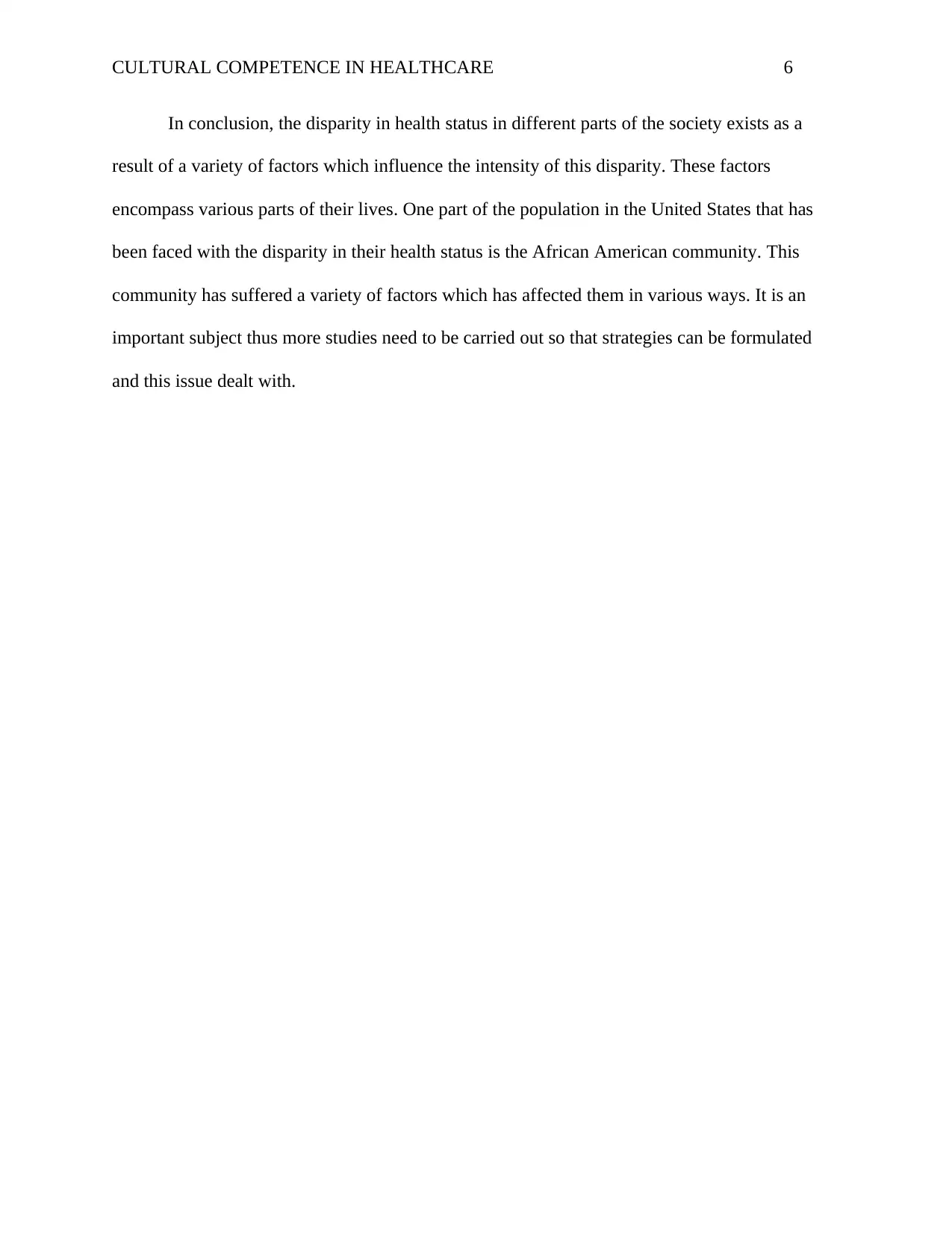
CULTURAL COMPETENCE IN HEALTHCARE 6
In conclusion, the disparity in health status in different parts of the society exists as a
result of a variety of factors which influence the intensity of this disparity. These factors
encompass various parts of their lives. One part of the population in the United States that has
been faced with the disparity in their health status is the African American community. This
community has suffered a variety of factors which has affected them in various ways. It is an
important subject thus more studies need to be carried out so that strategies can be formulated
and this issue dealt with.
In conclusion, the disparity in health status in different parts of the society exists as a
result of a variety of factors which influence the intensity of this disparity. These factors
encompass various parts of their lives. One part of the population in the United States that has
been faced with the disparity in their health status is the African American community. This
community has suffered a variety of factors which has affected them in various ways. It is an
important subject thus more studies need to be carried out so that strategies can be formulated
and this issue dealt with.
⊘ This is a preview!⊘
Do you want full access?
Subscribe today to unlock all pages.

Trusted by 1+ million students worldwide
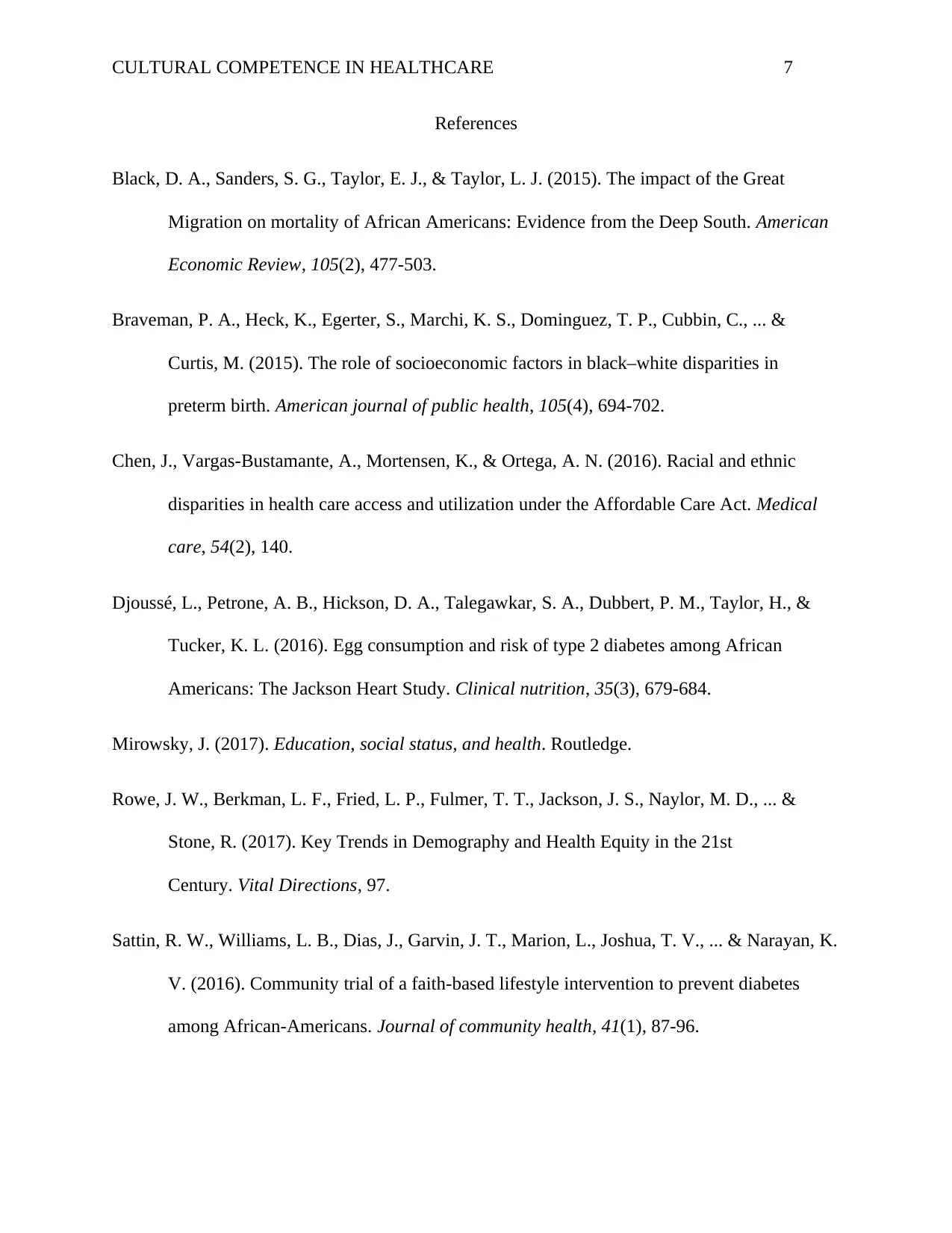
CULTURAL COMPETENCE IN HEALTHCARE 7
References
Black, D. A., Sanders, S. G., Taylor, E. J., & Taylor, L. J. (2015). The impact of the Great
Migration on mortality of African Americans: Evidence from the Deep South. American
Economic Review, 105(2), 477-503.
Braveman, P. A., Heck, K., Egerter, S., Marchi, K. S., Dominguez, T. P., Cubbin, C., ... &
Curtis, M. (2015). The role of socioeconomic factors in black–white disparities in
preterm birth. American journal of public health, 105(4), 694-702.
Chen, J., Vargas-Bustamante, A., Mortensen, K., & Ortega, A. N. (2016). Racial and ethnic
disparities in health care access and utilization under the Affordable Care Act. Medical
care, 54(2), 140.
Djoussé, L., Petrone, A. B., Hickson, D. A., Talegawkar, S. A., Dubbert, P. M., Taylor, H., &
Tucker, K. L. (2016). Egg consumption and risk of type 2 diabetes among African
Americans: The Jackson Heart Study. Clinical nutrition, 35(3), 679-684.
Mirowsky, J. (2017). Education, social status, and health. Routledge.
Rowe, J. W., Berkman, L. F., Fried, L. P., Fulmer, T. T., Jackson, J. S., Naylor, M. D., ... &
Stone, R. (2017). Key Trends in Demography and Health Equity in the 21st
Century. Vital Directions, 97.
Sattin, R. W., Williams, L. B., Dias, J., Garvin, J. T., Marion, L., Joshua, T. V., ... & Narayan, K.
V. (2016). Community trial of a faith-based lifestyle intervention to prevent diabetes
among African-Americans. Journal of community health, 41(1), 87-96.
References
Black, D. A., Sanders, S. G., Taylor, E. J., & Taylor, L. J. (2015). The impact of the Great
Migration on mortality of African Americans: Evidence from the Deep South. American
Economic Review, 105(2), 477-503.
Braveman, P. A., Heck, K., Egerter, S., Marchi, K. S., Dominguez, T. P., Cubbin, C., ... &
Curtis, M. (2015). The role of socioeconomic factors in black–white disparities in
preterm birth. American journal of public health, 105(4), 694-702.
Chen, J., Vargas-Bustamante, A., Mortensen, K., & Ortega, A. N. (2016). Racial and ethnic
disparities in health care access and utilization under the Affordable Care Act. Medical
care, 54(2), 140.
Djoussé, L., Petrone, A. B., Hickson, D. A., Talegawkar, S. A., Dubbert, P. M., Taylor, H., &
Tucker, K. L. (2016). Egg consumption and risk of type 2 diabetes among African
Americans: The Jackson Heart Study. Clinical nutrition, 35(3), 679-684.
Mirowsky, J. (2017). Education, social status, and health. Routledge.
Rowe, J. W., Berkman, L. F., Fried, L. P., Fulmer, T. T., Jackson, J. S., Naylor, M. D., ... &
Stone, R. (2017). Key Trends in Demography and Health Equity in the 21st
Century. Vital Directions, 97.
Sattin, R. W., Williams, L. B., Dias, J., Garvin, J. T., Marion, L., Joshua, T. V., ... & Narayan, K.
V. (2016). Community trial of a faith-based lifestyle intervention to prevent diabetes
among African-Americans. Journal of community health, 41(1), 87-96.
Paraphrase This Document
Need a fresh take? Get an instant paraphrase of this document with our AI Paraphraser
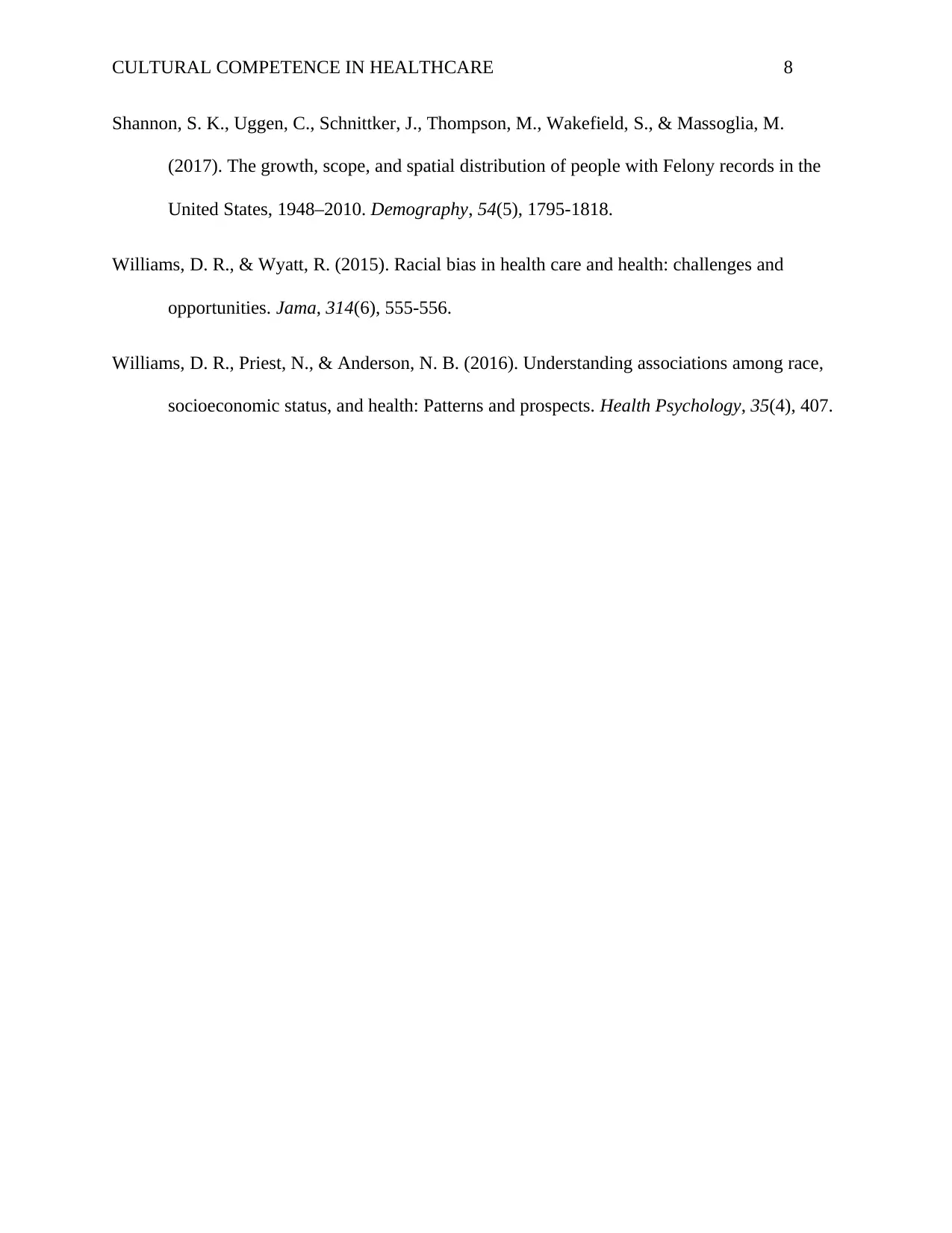
CULTURAL COMPETENCE IN HEALTHCARE 8
Shannon, S. K., Uggen, C., Schnittker, J., Thompson, M., Wakefield, S., & Massoglia, M.
(2017). The growth, scope, and spatial distribution of people with Felony records in the
United States, 1948–2010. Demography, 54(5), 1795-1818.
Williams, D. R., & Wyatt, R. (2015). Racial bias in health care and health: challenges and
opportunities. Jama, 314(6), 555-556.
Williams, D. R., Priest, N., & Anderson, N. B. (2016). Understanding associations among race,
socioeconomic status, and health: Patterns and prospects. Health Psychology, 35(4), 407.
Shannon, S. K., Uggen, C., Schnittker, J., Thompson, M., Wakefield, S., & Massoglia, M.
(2017). The growth, scope, and spatial distribution of people with Felony records in the
United States, 1948–2010. Demography, 54(5), 1795-1818.
Williams, D. R., & Wyatt, R. (2015). Racial bias in health care and health: challenges and
opportunities. Jama, 314(6), 555-556.
Williams, D. R., Priest, N., & Anderson, N. B. (2016). Understanding associations among race,
socioeconomic status, and health: Patterns and prospects. Health Psychology, 35(4), 407.
1 out of 8
Related Documents
Your All-in-One AI-Powered Toolkit for Academic Success.
+13062052269
info@desklib.com
Available 24*7 on WhatsApp / Email
![[object Object]](/_next/static/media/star-bottom.7253800d.svg)
Unlock your academic potential
Copyright © 2020–2025 A2Z Services. All Rights Reserved. Developed and managed by ZUCOL.





